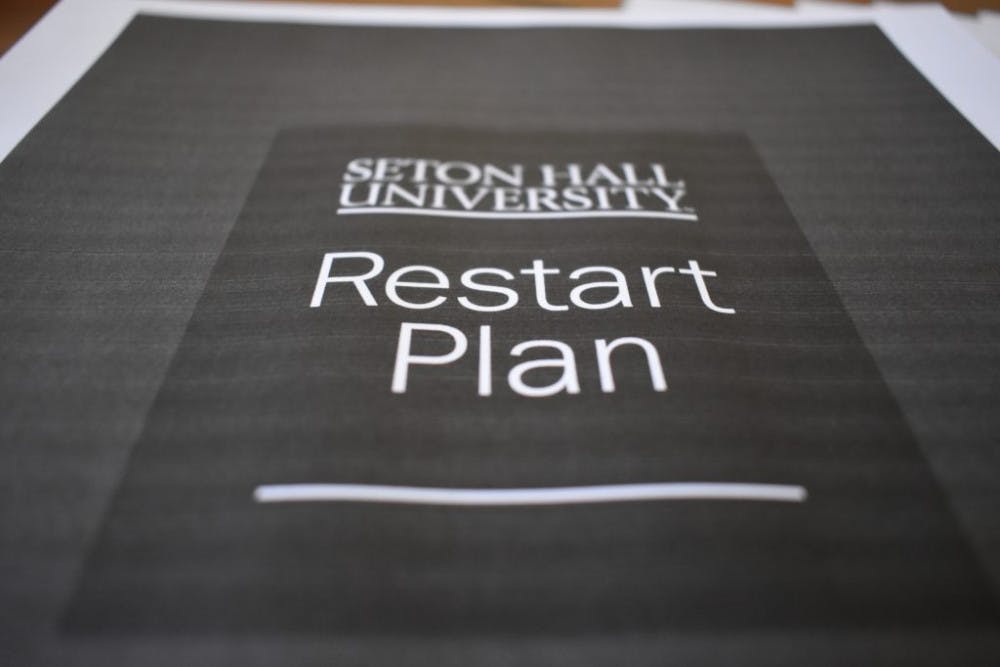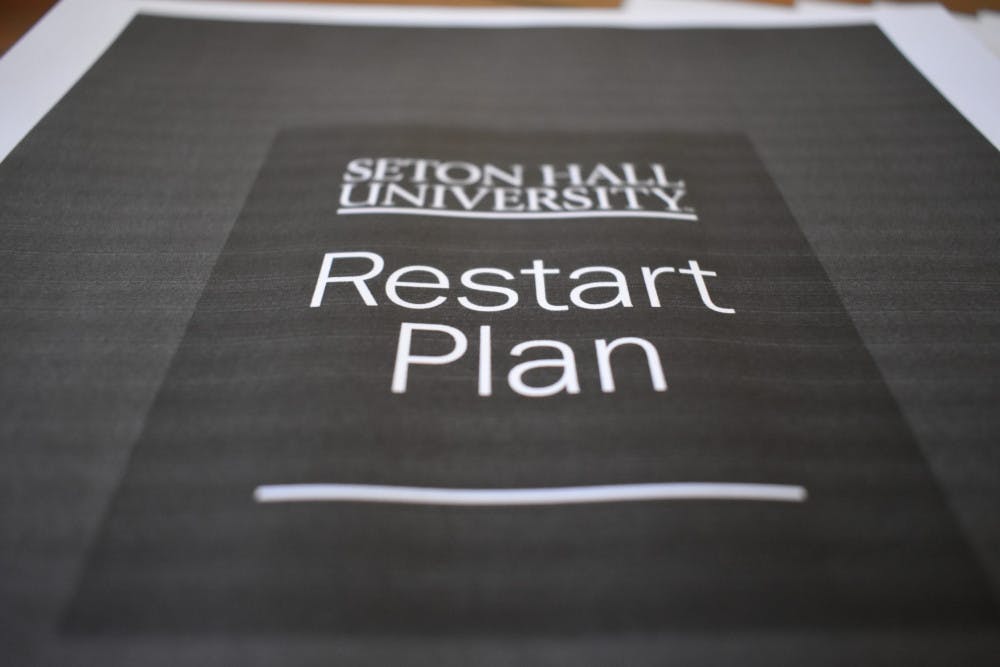Seton Hall’s in-person fall 2020 semester will be contingent on New Jersey’s ability to “safely enter Stage Three” of its reopening, according to a draft of the University’s restart plan submitted to the New Jersey Office of the Secretary of Higher Education on July 2.
The 67-page document, which was obtained by The Setonian on Monday following an Open Public Record Act request, has still not received feedback from the state and is still open to revision, but details how the University plans to reopen under its Hybrid Flexible educational model in accordance with state-mandated guidelines for the upcoming year.

“Consistent with the Re-Opening Operation Team (ROOT) communications to the community, Seton Hall’s restart plan was submitted to the State of New Jersey on July 2 for review by the Office of the Secretary of Higher Education, and remains in draft form until the plan is accepted,” University spokesperson Laurie Pine said in a statement. “Once accepted, the plan will be published in its entirety on the University website along with a summary to all students, faculty and staff. We continue to stay in contact with state officials as the review process is underway.”
The plan covers 11 different categories of campus life, including testing protocols, instruction, on-campus residence halls, athletics and student services, but lacks specific details on key questions for the fall, such as what the maximum capacity of the dining hall will be set at, what the total housing capacity for student isolation and quarantine dorm rooms is and what will happen if they become full.
According to the plan, when the University reopens, all individuals on-campus will be required to wear a face-covering indoors, with the exceptions in private offices and dorm rooms, and outdoors when social distancing is not possible.
In order to accommodate reduced capacity classrooms, Seton Hall noted in the plan that students will be “split into groups that will alternate online and in-class participation based on the last digit” of students' campus-wide ID numbers.
Members of the community will also be asked to abide by social distancing guidelines that the University plans to promote via a multimedia public health education campaign that will include a social contract called the “Seton Hall Pledge.” The pledge will, in part, list ways community members can protect themselves and others and will be included with a back-to-campus package provided to all students, staff and faculty that will contain two cloth face masks and a bottle of hand sanitizer.
According to the restart plan, aspects of the Pledge will be incorporated into relevant University policies, with the Student Code of Conduct being updated to reflect the expectations outlined in the Pledge.
The University is currently in the process of modifying campus areas to facilitate social distancing by installing plexiglass at instructor podiums in classrooms, for instance, and tasking the University’s facilities team with developing layouts for existing spaces to comply with social distancing protocols.
To supplement social distancing, Seton Hall will also implement a required self-screening examination for faculty, staff, visitors and students using a mobile app, which will require all individuals who plan to come to campus to consult a symptoms checklist each day and will require those who are experiencing any symptoms to stay home, though it is unclear how, if at all, the University would verify these results.
According to the plan, the app will enable the University to identify potential outbreaks early on and will model the plans of other universities, such as Creighton, who have developed or planned to use self-screening apps to enable safe fall returns without widespread surveillance testing.
Though it does not currently appear it will be used on the entire campus community, surveillance testing for “higher-risk subgroups of students” will also be used to monitor those who have an increased potential of infection because of the activities they participate in Seton Hall, such as student-athletes and students attending health clinicals.
The University will have the ability to test all other symptomatic students and contacts of infected or symptomatic people at the University’s Health Services building, though the plan does not list what the University believes its testing capacity will be for the fall, a key metric identified by the nation’s leading infectious disease specialist, Dr. Anthony Fauci, that will be essential to determining how colleges will reopen in the fall.
The details of the long-awaited fall plans come as the United States faces a nationwide resurgence of COVID-19 cases, with half of all states dealing with increased rates of new cases compared to last week.
New waves in dozens of states have prompted some, including New Jersey, to pause planned reopenings and again tighten restrictions. On Sunday, Florida set a grim new national record, with the state department of health reporting at least 15,299 new COVID-19 cases, the highest number of single-day cases in any state since the pandemic began, sparking questions in higher education about the safety of colleges reopening in the fall.
“The restart plan was developed through the expertise and input of many individuals, including external and internal health experts who work and teach at Seton Hall,” Pine said in a statement on the plan. “More than 140 members of the University community, including students, faculty, administrators and staff had a voice in the process.”
One sign of reopening-skittishness on the part of universities came from the University of Southern California, which announced in early July that its classes would take place primarily online, backtracking on an earlier plan to host in-person classes for students under a Hybrid Flexible model similar to Seton Hall’s.
“Given the continuing safety restrictions and limited densities permissible on campus, our undergraduate students primarily or exclusively will be taking their courses online in the fall term, and on-campus housing and activities will be limited,” USC Provost Charles Zukoski announced on July 2.
According to Seton Hall’s plan, it too can transition from in-person instruction to a fully remote model for a period of time or for the remainder of the semester if the campus experiences a surge of cases.
Some higher education experts, like Seton Hall professor Dr. Robert Kelchen, believe that colleges will inevitably be forced to pivot to an all online model.
“By the end of July, most colleges will have announced plans for a primarily online fall term, with only critical classes being held in person and limited residence-hall capacity for students who do not have other safe options,” Kelchen wrote in a recent piece for the Chronicle of Higher Education, citing a mix of factors including increasing percentages of people testing positive for the virus and large off-campus parties which have sparked surges of cases in college towns.
According to New Jersey’s Office of the Secretary of Higher Education, 28 restart plans have been submitted to date by various universities for review and approval by the state.
Just last week, Rutgers President Jonathan Holloway announced that instruction would take place primarily online at New Jersey’s largest public institution.
Princeton, another New Jersey college, recently announced that it would allow students to live on campus, but would cut its on-campus population in half by only allowing first-year students and juniors to attend in the fall, and sophomores and seniors to return in the spring. The school also said that even for its in-person students, most academic instruction will remain online.
Currently, it is unclear how many students plan to attend in-person classes at Seton Hall, but the University has a capacity of 2,202 beds under the new housing guidelines eliminating triples, down 306 beds from normal levels.
Nicholas Kerr can be reached at nicholas.kerr@student.shu.edu. Find him on Twitter @nickdotkerr.
CORRECTION, July 14, 2020: This article previously stated that the University has not received "approval" from the Office of the Secretary of Higher Education for its restart plan. The Office is not "approving" restart plans, it is "conducting a timely review to ensure institutions’ plans outline health and safety requirements, and we are following up with institutions if we identify concerns."





